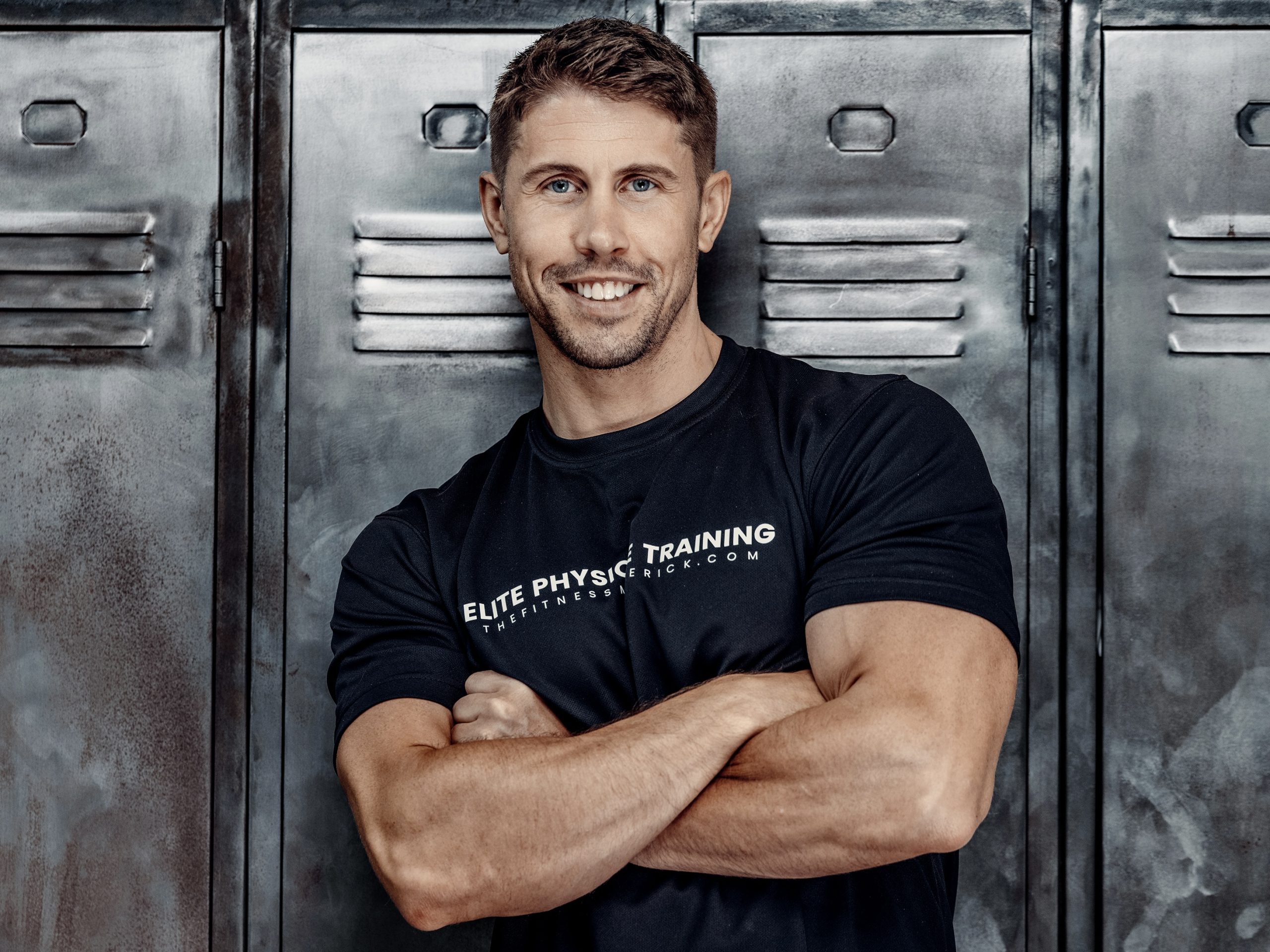Eccentric exercises offer a unique addition to your training with a mass of body composition and health benefits. From building more strength and muscle, to athletic performance, to injury prevention and treatment of tendinopathies.
Mechanical eccentrics are my favourite way to start introducing eccentric exercises to your upper body workouts. Find out why, and some simple exercises you can begin using today.
Basic science of eccentric exercises
When muscle fibers eccentrically lengthen they produce force because of both active and passive elements inside of them. The passive elements are elastic-type structures that produce force by resisting deformation, rather than by using energy to move. Whereas the active structures require energy.
You’ll likely have noticed you do a greater job of lowering a weight than you do lifting it. This is because on average you’ll be up to 25-40% stronger when lowering (the eccentric). This is because of the structures that come in to play during the eccentric contraction (extracellular matrix, the internal structure of the muscle fiber, and the giant molecule titin).
Eccentric training involves higher muscle forces, which can produce a large amount of mechanical tension and muscle damage. That’s two of the three proposed mechanisms that have been suggested as major factors in building muscle.
Eccentric training has also been shown to better activate high-threshold motor units, which have a greater capacity for growth.
Eccentric TUT versus load
One way to tap in to the eccentric portion of an exercise would be to increase eccentric time-under-tension (e.g., 5-8 second slow eccentrics). There’s little scientific evidence for or against focusing on eccentric duration. But it makes sense from a mechanistic (and real-world) perspective that it would help drive hypertrophy.
We’ll not be focusing on this topic today, as we’re more concerned with how to increase eccentric LOAD and absolute mechanical tension, rather than the time spent there. Despite not focusing on eccentric time with these exercises, I’d still recommend you fight the resistance on the way down (2-4 seconds).
Mechanical eccentrics
In order to tap in to this greater eccentric capacity you need to consider how you might increase eccentric loading of an exercise. You might have a few techniques come to mind:
- 2/1 eccentrics: Sometimes called BANA eccentrics (bilateral assisted negative accentuated). Lift with two-limbs and lower with one.
- Partner eccentrics: Your gym buddy will either assist you on the concentric portion of a lift, or apply some weight on the eccentric.
- Cheat eccentrics: For example cheat up a biceps curl with your hips, then lower under control.
- Weight releasers: Sometimes termed augmented eccentrics. I’ve personally had research published and have presented at conferences on these. I’m a big fan, but they’re highly impractical for most!
- Mechanical eccentrics: The topic of today.
What I like to term mechanical eccentrics are simply where you manipulate body position in order to overload the eccentric. The concentric portion of the lift is performed in an easier position, while the eccentric is done at a relative mechanical disadvantage.
More typically a manipulation in lever arm length is the change that’s made mid-way through each exercise. Put simply, on the lowering phase you’ll be in a position to make the most of that extra 25-40% strength capacity.
If you frequently get your fitness nerd on, you’ll likely have seen plenty of exercises that fall under this category when scouring the net. But you often see them bunched together among other eccentric exercises.
For both muscle-building and practicality purposes mechanical eccentrics deserve a few minutes under the spotlight. Here are five upper body exercises that use the mechanical eccentrics method.
The exercises
Want bigger, stronger and bulletproof shoulders? Try doing your lateral raises like this! Performing lateral raises like this will overload your medial deltoids eccentrically – raising with your elbows bent then lowering with them straight is a simple show of an increased lever length overloading the downward portion.
Using the scapular plane (raising 30 degrees forwards) has its benefits too, and a range I recommend most my clients use when doing any lateral raise variation. Using the scapular plane will allow better joint centration, while easier on your rotator cuff tendons. It’s great for those seeking a more “joint-friendly” shoulders exercise.
In 1999 the late Charles Poliquin wrote an article at T-Nation.com titled “The Swiss Ball Arm Workout”. It featured a description of the Gagné Triceps Extension performed on a Swiss Ball. Unfortunately, there were no videos included, nor can I find any on the web. Until now.
Here’s my take on them. The original article described a 1-Arm version where your upper back should be rested (and hinged) on a Swiss ball. I’ve decided to omit the Swiss ball for a bench, and use 2-arms instead of one.
I feel you can create the same “hinge”on the side of a bench, while also being more stable. That’s not to say these are better than what Poliquin proposed, I just feel they’re an easier introduction to the exercise.
These work via a greater eccentric overload of your triceps long-head in their stretched position (hips dropped), while tension is also maintained at the top (hips up). Maximal tension on your triceps is also better maintained throughout.
If you’re insanely sadistic and chasing some crazy biceps DOMS then try these.
Set-up – Use an incline bench set to a 75 degree angle. Your cables should be set to a low position, and create a 90-100 degree angle at the bottom of the curl (swipe right for picture). Of course there’s leeway here, but if you want to optimize then set-up angles matter!
1 – Lean forward to perform the concentric portion of the curl.
2 – Squeeze your biceps hard and hold your elbows in the flexed position as you lean back in to the bench.
3 – Lower the cable back down to its starting point. Here you’re overloading the eccentric portion of the curl and adding tension to your biceps long-head in their fully lengthened state.
4 – Repeat steps 1-3 until you’ve reached concentric failure.
Of all the eccentric exercises here, these will be the most likely you’ll have seen and tried before. You can do them on a flat, incline or decline bench. You can even do them as a floor press/flye variation.
Since you’ll likely be stronger at performing a squeeze press than you will a dumbbell flye, you’ll be overloading the eccentric portion of the flye with a greater weight than you would typically flye with.
Squeeze Pressing on the way up is the easier portion, but a good chance for you to keep some tension and still get in a good squeeze (something a standard flye lacks).
Since these can be a little questionable for those with cranky shoulders, I do suggest a slower eccentric phase so as to control the tension at the bottom better (where you’ll be most vulnerable with dumbbells).
You could also do these with cables standing, cables seated, or cables lying down. Kettlebells work great too.
There’s no point building big pecs and shoulders if you don’t have a back to match. Inverted rows are a great way to hit your traps and rhomboids, and help pull everything back where it should be – Unless you want to look like a rounded-back gorilla that-is.
Here’s a neat variation courtesy of Dr Joel Seedman that works to eccentrically load your inverted rows. These are a bit out-there for some (it’s not something I’d program for most of my online coaching clients anyway, without the hands-on instruction), but it can be a very useful drill.
As your hip is bent the band is more slack (lower load). It’s also easier to pull yourself up because of the shortened lever arm (lower load). When you straighten your hips on the lowering phase the lever arm is greater (more load) and there’s more tension in the band (more load).
If you can manage to hit double-figure reps with these you’re pretty badass!
Programming
There are a variety of ways you could program these in to your upper body training. To build muscle just 3 sets of 8-10 reps would work well, using 2-4 seconds to lower the weight down.
You could also employ longer duration eccentrics taking 5-8 seconds to lower and just 5-7 reps per set. Of course these recommendations would vary depending on a variety of factors.
One big recommendation though, would be to not get too carried away with these. You’ll be creating a lot of mechanical stress and tissue breakdown here, so use sparingly with a max of two of these per workout.


Thanks for the ideas presented here. I’ve not used these as of yet but I am using eccentrics in other areas to rehabilitate various injuries. Good info on your website.
That means a lot thank you. I just wrote this one today if you’re interested in eccentric hamstring training. http://35.177.251.119/nordic-hamstring-curl/